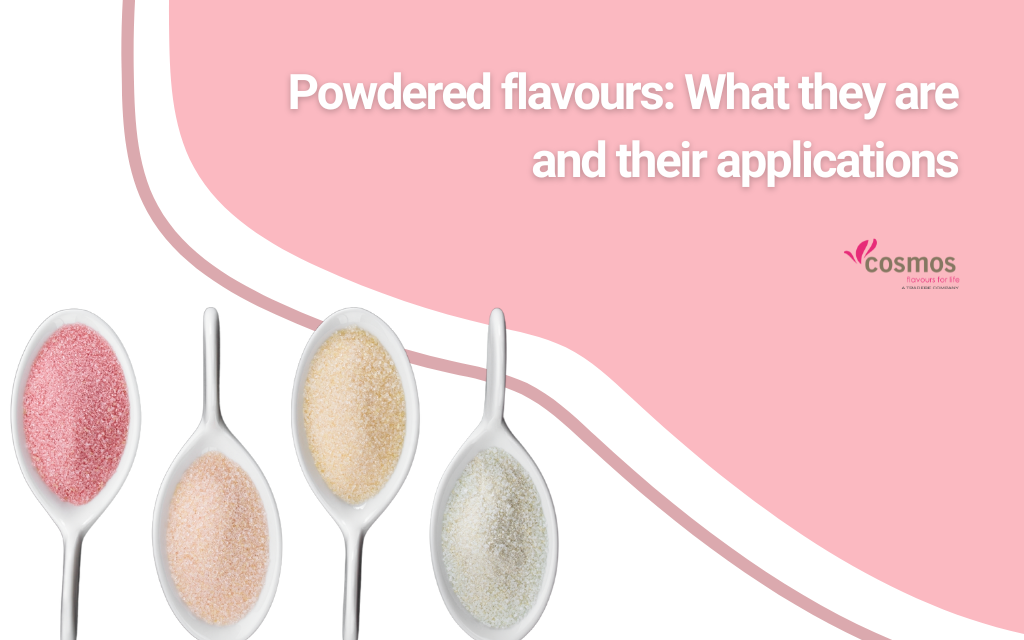Powdered flavours are redefining the food industry, enriching foods and beverages with an unprecedented sensory variety.
These key ingredients, sourced from both natural and artificial origins, not only enhance the taste profile of a product but are also crucial for consumer satisfaction.
Let’s explore how these powdered flavours have transformed the manufacturing and preservation process of foods, ensuring that aromas remain potent and authentic from production to consumption.
1. What are Powdered Flavours?
Powdered flavours are essential ingredients in the food industry, used to intensify or recreate specific tastes in various products. Their production is based on advanced techniques that allow either the extraction and concentration of flavours from natural sources or their chemical synthesis in laboratories. This distinction gives rise to two main categories:
Natural FlavoursNatural flavours are extracted directly from sources like fruits, spices, or herbs. Their main advantage lies in providing an authentic and genuine flavour profile, highly appreciated by consumers seeking products with natural ingredients.
Artificial Flavours
Designed in laboratories to mimic natural flavours or to create entirely new tastes, artificial flavours offer an intensity and stability that natural ones often cannot provide. This makes them ideal for products that require a prolonged shelf life or must endure intensive manufacturing processes without losing their flavour profile.
2. Origin and Development of Powdered Flavours
The history of powdered flavours dates back to the early 20th century when the food industry began exploring methods to preserve the taste of processed foods and extend their freshness and appeal. Initially, efforts focused on using simple extracts derived from natural sources like fruits and spices.
Over the decades, especially in the latter half of the century, flavour production technology made a significant leap with the development of encapsulation methods. In the 1950s and 1960s, microencapsulation techniques were introduced, marking a revolutionary change in the flavour industry. This technology allowed flavours to be enclosed in microcapsules that gradually release their content, ensuring that flavours remained potent even under the most demanding processing conditions.
These technological advances not only significantly improved the quality and stability of flavours but also opened the door to the creation of new products, enhancing the diversification and expansion of offerings in the global market. The ability to maintain consistent and long-lasting flavours has been key to the success of many food products in the international market, allowing traditional recipes and flavours to transcend borders and cultures.
3. Powdered Flavour Production Process
The production process of powdered flavours is a meticulous procedure divided into several key stages, each vital to ensuring the quality and efficacy of the final product. Here we detail each step of the process:
Selection of Raw Materials
The first step in the production of powdered flavours is the rigorous selection of raw materials. These can include fruits, spices, herbs, and other natural ingredients. The quality of these raw materials is crucial, as it determines the quality of the resulting flavour.
Extraction
Once selected, the raw materials undergo an extraction process to isolate the desired aromatic components. This process can employ various methods, such as distillation or the use of solvents. Each method has its advantages and is chosen based on the raw material and the desired flavour type.
Drying
After extraction, the obtained extracts undergo a drying process. This step is fundamental to converting the liquids into fine, manageable powders. Drying must be carefully controlled to preserve the integrity and potency of the flavour.
Encapsulation
Encapsulation technology plays a crucial role in the production of powdered flavours. This technique encases the flavour extracts in a protective matrix, helping to preserve the aromatic integrity of the flavours during storage and transport. Additionally, encapsulation ensures a controlled release of flavour in the final product, which is essential for flavour consistency in food applications.
Quality Control and Storage
Finally, encapsulated powdered flavours undergo rigorous quality controls to ensure they meet the required specifications. Once approved, the products are stored in conditions that guarantee their stability until they are shipped to food and beverage manufacturers.
Each of these steps is vital to ensuring that powdered flavours deliver a desired and consistent sensory experience, meeting consumer expectations and industry regulations.
4. Applications of Powdered Flavours in the Food Industry
Powdered flavours are versatile and essential components in various areas of the food industry, offering practical solutions to enhance and maintain flavour consistency in a wide range of products. Here we detail some of their main applications:
Beverages
In the beverage sector, powdered flavours are fundamental for creating varieties of energy drinks, soft drinks, and instant drink mixes. They provide vibrant flavours and freshness, allowing manufacturers to offer a wide range of options. The stability of these flavours under varying storage conditions and during the dilution process is particularly valuable.
Processed Foods
Powdered flavours also play a crucial role in the processed food industry, including products like instant soups, quick meal seasonings, and snacks. Here, they ensure the uniformity and durability of flavour, essential characteristics for consumer acceptance. Their ability to integrate homogeneously into products during manufacturing enhances the overall taste experience.
Baked Goods and Snacks
In the realm of baking and snacks, powdered flavours are used to enrich products like cookies, cakes, and potato chips. They allow for uniform distribution of flavour throughout the product and can withstand high temperatures during baking, ensuring that the flavour profile remains from the first bite to the last.
Nutrition and Supplements
Powdered flavours also find applications in the nutrition and supplements sector, particularly in the production of protein bars, nutritional powders, and dietary supplements. They provide a pleasant taste to products that might otherwise be bland or have unpleasant taste profiles, thus increasing their consumer acceptance.
5. Regulations and Certifications in the Flavour Industry
The flavour industry, especially in the production of powdered flavours, is subject to a rigorous regulatory framework designed to ensure food safety and quality. This framework includes both national and international regulations, and obtaining specific certifications is crucial for companies in the sector. Let’s break down the main regulations and certifications that govern this industry:
National and International Regulations
The regulations overseeing the production of powdered flavours vary from country to country, but all aim to ensure that products are safe for consumption and produced under ethical and responsible practices.Internationally, organizations like the Food and Drug Administration (FDA) in the United States, the European Food Safety Authority (EFSA) in Europe, and similar bodies in other regions, establish strict standards that companies must meet. These regulations cover everything from ingredient selection to manufacturing processes and labelling.
ISO Certifications
The ISO (International Organization for Standardization) series of standards is widely recognized and respected in the global food industry. Specifically, ISO 22000 focuses on food safety and manages systems that ensure food does not pose hazards to consumers. Companies that obtain this certification demonstrate their ability to control food safety hazards and comply with applicable regulations.
FSSC 22000 Certification
FSSC 22000 Certification is another crucial one specific to food safety. It is based on ISO 22000 but includes additional requirements that are particularly relevant for large-scale manufacturing, such as the production of powdered flavours. This certification is recognized by the Global Food Safety Initiative (GFSI), making it particularly valuable for companies operating in or exporting to international markets. It assures consumers that products meet the highest standards of safety and quality.
Conclusion
Powdered flavours are more than just ingredients; they are catalysts for innovation in the food and beverage industry. Their ability to transform basic products into memorable culinary experiences is invaluable. As we move forward, the integration of new technological developments and a deeper understanding of consumer preferences will continue to dictate their evolution and prevalence in the global market.










